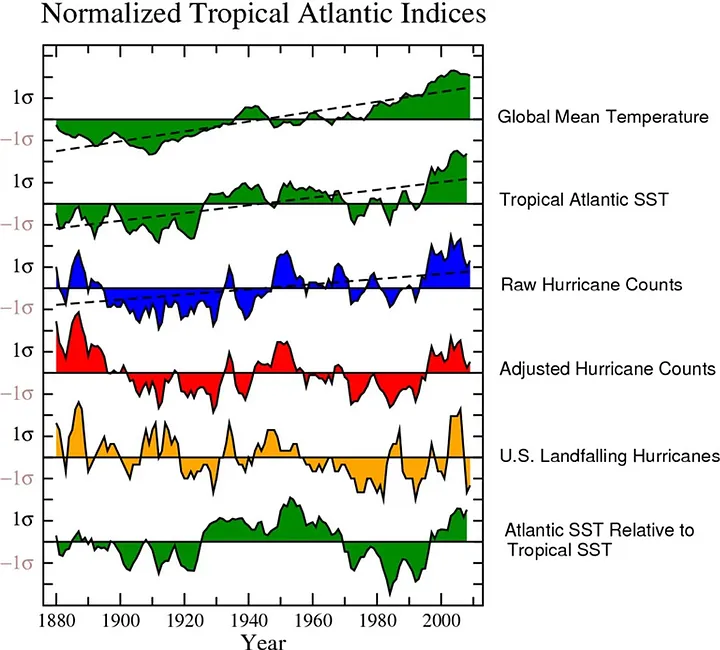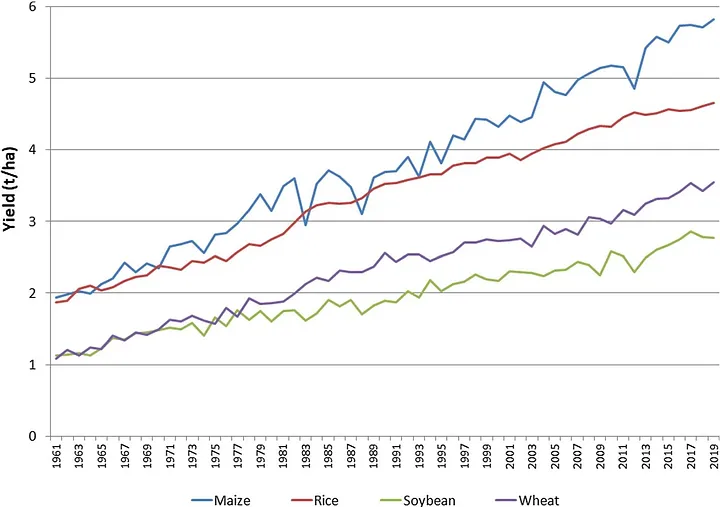“Global warming canceled.” Not really


· 6 min read
In January 2022, The European Physical Journal — Plus published an article by four Italian researchers “A critical assessment of extreme events trends in times of global warming”. And although the authors of the article are not in a hurry to deny global warming in general, focusing on heat waves, droughts, tornadoes, floods, and the productivity of basic crops, their work was suddenly taken up by people who believe that anthropogenic global warming does not exist, and the scientific consensus about it is the result of a conspiracy. They were joined by those who simply do not want global warming to happen. The article was joyfully spread across the Internet, and declared “an indictment of our era, saturated with thoughtless and idiotic belief in the speculative hypothesis of an impending climate catastrophe”.
A. Heat waves (taken only in the summer season). Without any reason (not even a single graph), it is concluded that their intensity trends are not significant. This is a direct fraud on the part of the authors. The analysis of heat waves is not simple, but the work systematically shows an increase in their frequency and intensity. See for example. Jan Oldenborgh, G., Wehner, M. F., Vautard, R., Otto, F. E. L., Seneviratne, S. I., Stott, P. A., Hegerl, G. C., Philip, S. Y., & Kew, S. F. (2022). Attributing and projecting heat waves is hard: We can do better. Earth’s Future. https://doi.org/10.1029/2021EF002271. Yes, and at the philistine level, it is clearly visible.
B. Tropical cyclones and tornadoes, i.e. wind. Here the whole game is based on the introduction of corrections to the historical series of observations. The authors DO NOT describe what amendment methodology they use, they do not even provide references. Just as it is not clear, Fig. 2 they drew or copied from somewhere

Figure 1: Figure 2 from the article under discussion by Italian scientists. Historical trend of normalized rates for the Atlantic Tropical Zone from 1880 to the present.
What is important, however, is that they assume that warming should lead to an increase in the frequency and strength of tropical cyclones, which is not the case. Changes in the strength of atmospheric currents, which, with climate warming, are shifting northward from areas of tropical cyclone formation, lead to a reduction in the number and strength of cyclones. This conclusion is reached by the same C.W. Landsea, whose early work they refer to. A detailed breakdown of trends and causes is here: https://www.carbonbrief.org/tropical-cyclones-now-13-less-frequent-due-to-climate-change/. The same can be said about tornadoes: these phenomena are associated with the interaction of large-scale flows with convective clouds. Tornadoes are everywhere in one form or another, but the American Midwest is notable for its particular frequency. The reason for this is the northern invasions through the Rocky Mountains. Accordingly, more rapid climate warming in the northern latitudes (and this is a fact) leads to weakening such invasions and weakening the strength of tornadoes.
C. Phenomena associated with precipitation (showers, floods, droughts). Here in the article, the trick of mixing in a bunch of everything is used. An analysis of observations and climate models clearly shows that the change in precipitation is associated with a shift in planetary centers of action — stable areas of high and low pressure. In Europe, the Mediterranean has drier weather, while northern Europe has wetter weather. The data presented in the article describes the same. At the same time, the shower form of precipitation becomes predominant if conditions for convection are created, and this is not at all necessary with climate warming. Rather the opposite. All this is described in the latest IPCC report. A good integral indicator of the ratio of precipitation and evaporation is river runoff, for which there are long and reliable series of observations, but for some reason, the authors are silent about this. See Blöschl, G., Hall, J., Viglione, A., Perdigão, R. A. P., Parajka, J., Merz, B., Lun, D., Arheimer, B., Aronica, G. T., Bilibashi, A., Boháč, M., Bonacci, O., Borga, M., Čanjevac, I., Castellarin, A., Chirico, G. B., Claps, P., Frolova, N., Ganora, D., … Živković, N. ( 2019). Changing climate both increases and decreases European river floods. Nature, 573(7772), 108–111.
D. Grain yield. As in the three previous cases, misunderstanding the phenomenon's nature played a cruel joke on the authors. The fact is that the main grain-producing regions are located in such a way that negative phenomena in one of them are offset by positive ones in the other. In addition, the main crops, by definition, are resistant to bad weather — the entire thousand-year selection went in this direction. Therefore, their productivity is influenced rather by other factors, as Figure 7 shows. The productivity of natural ecosystems depends on climate change in very different ways, even for different plant species in ecosystems. However, the productivity of natural systems is also growing, see https://www.nature.com/articles/s41597-022-01309-2.

Figure 2: Figure 7 from the article under discussion. Time series of average world yields (t/ha) of corn, rice, soybeans, and wheat for 1961–2019.
The article is a very limited review of some, more or less accidentally tugged, publications. The authors have no understanding of the scientific basis of climate change and its impact on various processes and phenomena. And in vain, if they did read the IPCC report, they could put their time and effort to better use, because there is no doubt that the report also contains lacunae, ambiguities, and even errors. That is why the topic of climate change and the nature of individual climatic extreme events has not been closed so far. But such a study should be based on the understanding that has already been achieved, and not on imaginary problems with calculating trends.
This article is also published in the author's blog. illuminem Voices is a democratic space presenting the thoughts and opinions of leading Sustainability & Energy writers, their opinions do not necessarily represent those of illuminem.
Gokul Shekar

Effects · Climate Change
Simon Heppner

Effects · Climate Change
illuminem briefings

Climate Change · Effects
The Guardian

Agriculture · Climate Change
Euronews

Climate Change · Effects
The Wall Street Journal

Climate Change · Effects